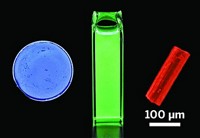Advertisement
Grab your lab coat. Let's get started
Welcome!
Welcome!
Create an account below to get 6 C&EN articles per month, receive newsletters and more - all free.
It seems this is your first time logging in online. Please enter the following information to continue.
As an ACS member you automatically get access to this site. All we need is few more details to create your reading experience.
Not you? Sign in with a different account.
Not you? Sign in with a different account.
ERROR 1
ERROR 1
ERROR 2
ERROR 2
ERROR 2
ERROR 2
ERROR 2
Password and Confirm password must match.
If you have an ACS member number, please enter it here so we can link this account to your membership. (optional)
ERROR 2
ACS values your privacy. By submitting your information, you are gaining access to C&EN and subscribing to our weekly newsletter. We use the information you provide to make your reading experience better, and we will never sell your data to third party members.
Analytical Chemistry
Wide-Range Fluorescent pH Sensor
Molecular device emulates glass pH electrode
by Michael Freemantle
February 28, 2007
A new molecular sensor that matches the pH range of glass pH electrodes could be used for measuring pH in biological cells and microfluidic devices (J. Am. Chem. Soc., DOI: 10.1021/ja0686514).
The sensor, designed by A. Prasanna de Silva at Queen's University, Belfast, Northern Ireland, and coworkers, consists of four disubstituted anthracenes that fluoresce in parallel over different pH ranges by a mechanism of photoinduced electron transfer. The anthracenes have a fluorophore-spacer-receptor design that uses the same fluorophore and spacers but different receptors with different proton-binding strengths.
The pH of a solution containing equal concentrations of all four components is directly proportional to the summed fluorescence intensities of the components at a specific wavelength. As such, this sensor works in an analog mode rather than a digital one. The sensor measures pH across nearly 10 pH units, whereas the range of classical molecular sensors is around two units.
The team suggests that the design could be used to construct wide-range sensors that target sodium and other species of chemical and biological interest.





Join the conversation
Contact the reporter
Submit a Letter to the Editor for publication
Engage with us on Twitter